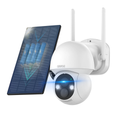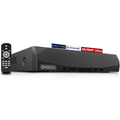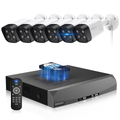Exterior Design of Surveillance Cameras - Insights from OHWOAI
Introduction:
The exterior design of surveillance cameras plays a crucial role in their functionality and effectiveness. In this article, we will explore how OHWOAI considers various aspects while designing surveillance cameras to meet diverse environmental and security requirements.
Adaptation to the Environment:
The exterior design should be tailored to the specific installation environment, whether it's indoor, outdoor, or in harsh weather conditions. Outdoor surveillance cameras require features like waterproofing, dust resistance, and durability to withstand different climate conditions.
Concealment:
For specific scenarios such as security surveillance, it's essential to consider designs that blend the appearance of the camera with the surroundings. Enhancing the concealment of the camera helps prevent detection and tampering.
Adjustability:
Some surveillance cameras require an adjustable exterior design, such as rotation and focus capabilities, to meet varying monitoring ranges and angles.
Simplicity and User-Friendliness:
The exterior design should prioritize simplicity and aesthetics while ensuring user-friendliness for easy installation, adjustment, and maintenance.
Transparency:
In places where it's crucial to showcase the purpose of the surveillance camera, such as security installations, an exterior design with some transparency can clearly indicate the camera's functions and presence.
Durability:
The choice of materials and construction in the exterior design should consider enhancing the camera's durability and resistance to tampering or damage.
Heat Dissipation:
For surveillance cameras that operate for extended periods, the exterior design should address heat dissipation concerns to ensure that the device performs optimally without overheating.
Indicator Lights:
Some surveillance camera designs incorporate indicator lights to display device status, such as operational status, recording status, etc.
Obstruction Protection:
The exterior design can include features to protect against obstructions that might hinder the camera lens, thereby preserving the effectiveness of monitoring.
Conclusion:
The exterior design of surveillance cameras is a crucial factor that impacts their functionality and performance. OHWOAI pays careful attention to adaptability, concealment, adjustability, user-friendliness, transparency, durability, heat dissipation, indicator lights, and obstruction protection in the design process. By addressing these aspects, OHWOAI aims to provide surveillance cameras that excel in different environments and applications while ensuring reliability and security.
The exterior design of surveillance cameras plays a crucial role in their functionality and effectiveness. In this article, we will explore how OHWOAI considers various aspects while designing surveillance cameras to meet diverse environmental and security requirements.
Adaptation to the Environment:
The exterior design should be tailored to the specific installation environment, whether it's indoor, outdoor, or in harsh weather conditions. Outdoor surveillance cameras require features like waterproofing, dust resistance, and durability to withstand different climate conditions.
Concealment:
For specific scenarios such as security surveillance, it's essential to consider designs that blend the appearance of the camera with the surroundings. Enhancing the concealment of the camera helps prevent detection and tampering.
Adjustability:
Some surveillance cameras require an adjustable exterior design, such as rotation and focus capabilities, to meet varying monitoring ranges and angles.
Simplicity and User-Friendliness:
The exterior design should prioritize simplicity and aesthetics while ensuring user-friendliness for easy installation, adjustment, and maintenance.
Transparency:
In places where it's crucial to showcase the purpose of the surveillance camera, such as security installations, an exterior design with some transparency can clearly indicate the camera's functions and presence.
Durability:
The choice of materials and construction in the exterior design should consider enhancing the camera's durability and resistance to tampering or damage.
Heat Dissipation:
For surveillance cameras that operate for extended periods, the exterior design should address heat dissipation concerns to ensure that the device performs optimally without overheating.
Indicator Lights:
Some surveillance camera designs incorporate indicator lights to display device status, such as operational status, recording status, etc.
Obstruction Protection:
The exterior design can include features to protect against obstructions that might hinder the camera lens, thereby preserving the effectiveness of monitoring.
Conclusion:
The exterior design of surveillance cameras is a crucial factor that impacts their functionality and performance. OHWOAI pays careful attention to adaptability, concealment, adjustability, user-friendliness, transparency, durability, heat dissipation, indicator lights, and obstruction protection in the design process. By addressing these aspects, OHWOAI aims to provide surveillance cameras that excel in different environments and applications while ensuring reliability and security.
Sample Block Quote
Nam tempus turpis at metus scelerisque placerat nulla deumantos sollicitudin delos felis. Pellentesque diam dolor an elementum et lobortis at mollis ut risus. Curabitur semper sagittis mino de condimentum.
Sample Paragraph Text
Lorem ipsum dolor sit amet, consectetur adipiscing elit. Morbi ut blandit risus. Donec mollis nec tellus et rutrum. Orci varius natoque de penatibus et magnis dis parturient montes, nascetur ridiculus mus. Ut consequat quam a purus faucibus scelerisque. Mauris ac dui ante. Pellentesque congue porttitor tempus. Donec sodales dapibus urna sed dictum.










